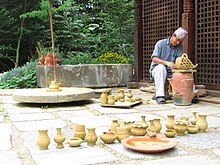Nepal Himalaya Pavilion
The Nepal-Himalaya Pavilion is the former Nepalese exhibition pavilion of the Expo 2000 in Hanover . It was bought by a patron and rebuilt in Wiesent in the Upper Palatinate district of Regensburg .
Emergence
In February 2000 the Nepalese pavilion was set up for the Expo 2000, which took place in Hanover from June 1 to October 31, 2000 and was attended by 178 nations and international organizations. It has a gilded tower 22 meters high and numerous detailed carvings. These were hand carved by 800 Nepalese craftsmen. The Nepalese building was one of the most popular international pavilions at the World's Fair, visited by around 3.5 million people.
After the exhibition ended, the manufacturer Heribert Wirth bought the pavilion. The building was dismantled into its individual parts and rebuilt true to the original in Wiesent, Upper Palatinate . It has been open to the public there since July 15, 2003.
According to the operator, it is the only building in which shrines of Buddhists and Hindus can be found together in one structure. It is surrounded by various gardens. These include a tea house , a Nepalese carillon and a large pond with a larger than life Buddha figure.
Gardens
One of the most species-rich public gardens in Germany with over 3000 different plant species was created around the pavilion. The entire site is located in a former quarry on the southern foothills of the Bavarian Forest , above the Danube . The climate is hot and dry in summer, mostly snowy and cold in winter. The stony soils were partially improved with loamy soil from the Danube plain and with peat .
The garden of the pavilion houses a heather garden , dry slopes, moist meadow-like beds, dry and moist shady areas and two large ponds.
Due to the multitude of different environmental factors, also due to the hillside location, which strongly structures the garden, many different plants can be cultivated successfully. According to the designers, it is a matter of presenting the visitors with a comprehensive representation of the perennials and woody plants that can be cultivated in the Upper Palatinate, as close to nature as possible.
Numerous wild perennials from all over the world play an important role in this concept, but also varieties that are tried out and propagated here. One example is the Beth Chatto garden in eastern England.
The garden is defined as a public park , in which biodiversity is used to create natural combinations of plants in every season.
Part of the show garden houses over 1000 different plants from the Sino-Himalaya. Among others were Mannsschild species, Androsace , various Pulpit , many Poppy , various Corydalis , Corydalis , gentians , edelweiss , primroses , tiger bells , various Wildrhododendren and Saxifraga , and other shrubs and trees like Abelia triflora or Viola kunawarensis planted. Giant heart petals ( Cardiocrinum giganteum ) and a number of rare orchids ( Cypripedium cordigerum , Cypripedium henryi , Cypripedium himalaicum , Cypripedium macranthum and Cypripedium tibeticum ) can also be seen.
The gardeners try to test new plants with which there is little experience. Since Himalayan plants usually prefer a permanently humid climate, attempts are made to adapt the climatic conditions for these special plant species with watercourses, large stones, shading, spray mist or special soil mixtures.
sightseeing
The pavilion and park can be viewed from mid-May to early October during opening hours.
The operator forwards the proceeds from the entrance fees to the Water for the World Foundation , which finances water projects in the Third World.
In the exhibition complex, handicrafts from the Himalayas, original Nepalese tea and goods from a Nepalese potter are offered for sale.
Picture gallery
Web links
- Official website of the Nepal Himalaya Pavilion
- nepalhaus.de: PDF brochure
- http://www.haindling.de/people/h_wirth/index.html
- Photos of the pavilion of Nepal at the Expo 2000 Hanover
Individual evidence
- ↑ Official homepage of the Nepal-Himalaya Pavilion ( Memento of the original from June 26, 2011 in the Internet Archive ) Info: The archive link was automatically inserted and not yet checked. Please check the original and archive link according to the instructions and then remove this notice.
- ↑ nepal-himalaya-pavillon.de/Gartenanlagen ( Memento of the original from August 30, 2011 in the Internet Archive ) Info: The archive link has been inserted automatically and has not yet been checked. Please check the original and archive link according to the instructions and then remove this notice.
- ↑ nepal-himalaya-pavillon.de/opening times, entry etc. ( Memento of the original from October 4, 2011 in the Internet Archive ) Info: The archive link was inserted automatically and has not yet been checked. Please check the original and archive link according to the instructions and then remove this notice.
Coordinates: 49 ° 1 ′ 14.8 " N , 12 ° 22 ′ 23.7" E







